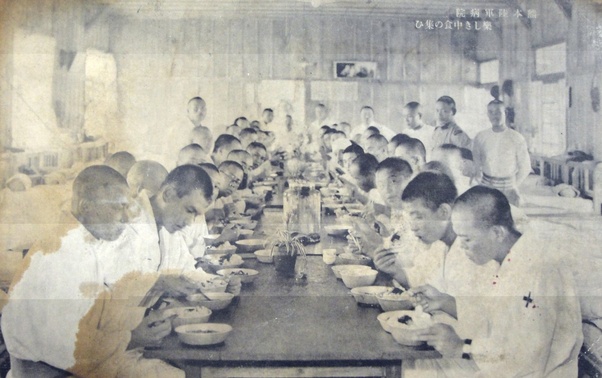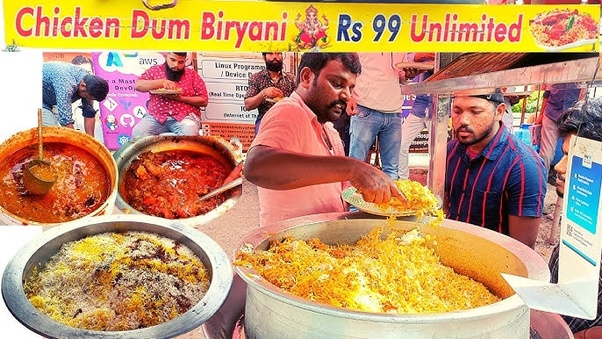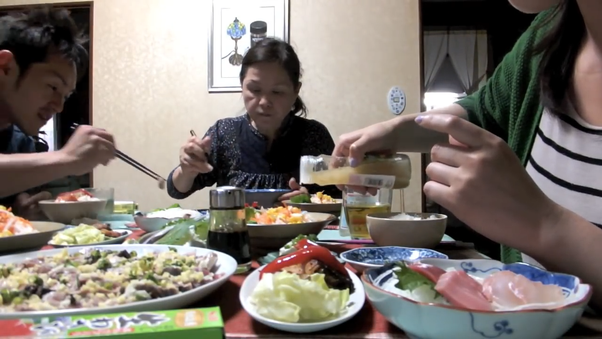

I recall reading a story of a German doctor visiting Japan, who was surprised by the reliance on white rice and minimal meat consumption, especially after hearing of the result of the Russo-Japanese war. A more-Western diet, rich in meat, believed to be superior for physical strength, was offered to a Japanese laborer.
However, the opposite was observed, to the doctor’s surprise—the laborer’s performance declined on the meat diet. The laborer regained their enduring stamina when they went back to white rice.
I believe in genetic adaptations, as if Japanese digestive systems became adapted to being fueled by rice. I suppose some others have genetic adaptations to sustain themselves on primarily animal-based food sources, such as those living at extreme northern latitudes (e.g. Inuits of Greenland).
Furthermore, I believe that the Western diet disrupted the laborer’s digestive system, similar to my personal experience trying unfamiliar foods from different cultures and getting peculiar bowel movements afterward.
There’s even evidence that suggests different adaptations between males and females, with male bodies seemingly handling carbs well, while females are more likely to get fatter from carbs, but handle fats better.
With today’s knowledge, this result should not come as a surprise. While meat is a high-quality source of protein and fat, it’s a fact that carbs are the body’s preferred fuel source, especially for sustaining non-stop high-intensity activity for hours. Carbs are more readily converted to glucose, which muscles use for quick energy.
Muscles store glucose as glycogen whenever given time to rest. Fat stores are an abundant source of energy, but it takes more time to break down into fuel, so it’s more ideal for low intensity activities (e.g. zone 2 cardio) when your glycogen is fully depleted.
The idea that white rice is not good for you is likely due to the culture of today changing to a more urbanized and sedentary lifestyle, as opposed to a physically intensive lifestyle. Carbs, often found in snacks and other convenience food, are made cheap and plentiful by government subsidies.
The obesity epidemic is being blamed on the sheer volume of carbs being consumed, which often are made into addictive hyper-palatable comfort foods. Important nutrients are removed by the refinement process; even with fortification, there is one important nutrient that is not added back: fiber.

^ In Pakistan, a South Asian country not so genetically adapted to metabolising white rice, type 2 diabetes is rampant. Is it rice or is it GLUTTONY that is to blame? Look at those quantities! For reference, 99 Pakistani Rupees is 0.36 USD.
Rice is undoubtedly subsidized there, making it a staple in their lives. The problem is that Pakistanis seemingly kept their habits of eating hearty meals despite the culture transistioning to a more sedentary one.
There are many misconceptions circulating that send mixed messages regarding nutrition: many incorrectly believe that carbs leads to obesity and diabetes. Fiber is a carb directly counters obesity and diabetes.
Ironically, the rising interest in low-carb diets has led people to increase red meat consumption, which has strong evidence that it’s a group 2A carcinogen. Also, contrary to popular belief, excess protein (over 0.8g/kg) does not turn into extra muscle mass for most people—it’s more about preventing muscle loss (the body finds excess muscle mass to be inefficient, and will shrink them down if they’re not being used).
In other words, some carbs are not as bad as others. There’s a lack of evidence that suggests white rice consumption increases the risk of all-cause mortality, while the same cannot be said for red meat, and possibly even other refined grain products like white bread and regular pasta (wheat).
Sugar-free/artificually sweeted “zero”-cal stuff isn’t safe either, as they can still raise insulin (e.g. known effect from sugar alcohols) and negatively alter the gut microbiome.
An exception is stevia, which has much less negative effect on the gut microbiome and insulin, but it has a host of other negative side effects, perhaps depending on genetics.
Those with concerns about diabetes should know that it is more about the body either being resistant to insulin, or the body’s immune system is removing insulin. Time-restricted/intermittent fasting gives a chance for insulin levels to drop, which improves insulin sensitivity (lowers risk of diabetes).
Consistently high insulin, such as a result from snacking/grazing and drinking sugary/caffeinated beverages throughout the day, puts you at more risk of diabetes than having a meal that spikes insulin sharply with many hours in of no eating afterward. It’s people who already have diabetes who should be concerned about glycemic load, not healthy people.
White rice was chosen to feed Japanese troops because brown rice spoiled in storage in mere months, especially in warm and humid environments. Before industrialization, white rice consumption was a status symbol for the elite due to the labor-intensive processing needed.
Thanks to industrialization, white rice became more accessible to the masses in the late 1800s; the prestige of white rice actually was used to attract military recruits, charmed by the prospect of eating their fill of it. Tragically, there were lethal consequences suffered by those who only ate white rice, due to a lack of thiamine (vitamin B1), which was removed by processing.
Thiamine deficiency, AKA beriberi, claimed the lives of not only soldiers, but also nobility. It wasn’t until the early 1900s that vitamins were isolated and recognized, that public health reforms were enacted to address this problem, through a stronger emphasis on a balanced diet, and later through fortification/enrichment.
Although enriched white rice states to not rinse it, due to the loss of nutrients, some people insist on rinsing away the starchy coating away for the sake of palatability. Some resourceful people save/repurpose the rice water as a nutrient-rich face wash, with some claiming it to be the secret to smooth skin. I even hear that some use it to occasionally water their plants, to surprisingly positive results.
Focus on individual nutrients like carbs, fats, protein, vitamins, etc. is considered to be a “reductionist” approach to nutrition, which is criticized as being blind to the big picture. When faced with a heart attack, people overwhelmingly begin to put faith in a plant-based diet. If one were to take a reductionist view on the plant-based diet, they’d note that it’s rich in fiber.
Fiber is one thing that low-carb diets lack, and what makes them so controversial. Japanese who consumed rice, typically did so with higher intake of soy products (e.g. tofu, edamame) and seaweed, with lower intake of meat.
The importance of fiber is not to be understated. A certain type of fiber, called beta-glucan, has been proven with scientific evidence to have a tremendous effect on weight managemen on top of evidence that shows it boosting the immune system
Foods rich in beta-glucan include: whole grain oats, barley, and mushrooms. Barley and mushrooms (e.g. maitake and shiitake) are traditionally eaten in Japan, with oatmeal and other oat-based foods becoming trendier. Seaweed isn’t as rich in beta-glucan, but it has other nutrients in it that boost the immune system and are anti-inflammatory. Rice has a very minor amount of beta-glucan.
Not all Japanese have a diet of white rice, soy products, and seaweed. Those who did make these staples of their diet measured the healthiest among various diet patterns.
The Japanese who choose a diet of bread and dairy have higher LDL and total cholesterol (high level of artery cloggers), higher fasting glucose (trouble regulating blood sugar levels), and lower C-reactive protein levels (made in response to inflammation).
Those who choose a noodle diet have a higher HDL and total cholesterol, higher hemoglobin A1c (high long-term blood sugar levels), and higher phosphorous levels (kidney not working well, and/or high acidity in blood which pulls structural elements out of bones).
There was a common pattern of Japanese having a high intake of mushrooms, seaweed, veggies, potatoes, fruits, pulses/legumes, and pickled veggies (e.g. pickled daikon radish, ginger, eggplant, etc.).
Dinner is considered to be the main meal in Japan. This is what a typical home-cooked family dinner looks like:

While white rice is said to be included with nearly every meal, vegetables evidently make up a large percentage of the dishes, with the primary protein being a piece of fish. The vegetables are a great source of soluble fiber, while fish are a great source of omega-3 fats like DHA and EPA.
While I mentioned the great benefits of fiber, DHA and EPA deserve great attention, as well, being essential for brain building and seemingly countering the many ailments caused by saturated fats, such as inflammation, high blood pressure, excessive triglyceride levels, weight gain, etc.
Seaweed happens to have fiber, DHA, EPA, and many other nutrients, but there’s also evidence that the Japanese adapted to be able to digest it well. Non-Japanese should not expect to get as much benefit from eating seaweed due to genetic differences that affect how well their body metabolizes it.
In pictures and videos, I see a lot more Japanese traveling on foot, in great contrast to the amount of car dependency witnessed in the USA and other Western first-world countries. I find this kind of market fascinating (Minami-Aoyama Farmer’s Market in Tokyo):

I’m seeing strange vegetables that I’ve never seen before, such as Kogomi (ostrich/fiddlehead fern). Witnessing Japanese youths eat this sheer volume of vegetables is quite shocking to me. In the US, even adults are so picky with vegetables that it’s actually considered to be a bragging right to be able to eat asparagus, mushrooms, eggplant, artichoke, beet, butternut squash, zucchini, radish, turnips, okra, olives, collard greens, etc.
Even relatively neutral tasting vegetables like bell peppers, celery, spinach, and lima beans, are somewhat contested whether or not it’s worth bragging about.
Genetics have been found to affect how foods can taste. Some people taste soap from cilantro/coriander, celery, and cucumber. Some people find broccoli, brussel sprouts, cauliflower, cabbage, and kale extremely bitter, while others might find them mild or sweet. Some smell/taste sulfur in asparagus (and eggs, esp hard boiled), or at least sense it in their urine after eating it.
Some people find a sharp medicinal taste in licorice, fennel, and caraway, while others find them sweet. Same goes for certain people who find coffee, alcohol, dark chocolate, seafood, grapefruit, and even water to have relatively repulsive tastes/smells, which can change as they grow up and their body changes.
The fact is that rice is energy. Metabolic diseases see it as energy, too, but if you don’t have such diseases in the first place, you can be at ease when taking advantage of the fact that this energy is preferentially used to fuel activities that demand very high physical intensity and mental exercises for long durations.
Your genetics are greatly tied to metabolism—some can eat beans and have minimal flatulence, and some can eat dairy without the associated gut issues of lactose intolerance. People are simply just becoming more aware of their sensitivities, like those with celiac disease with the sensitivity to gluten (protein in wheat, barley, and rye).
Japanese people are genetically adapted to rice and seaweed, especially Japanese men, to a far greater extent than people of different descent. It’s strange to be influenced by fad diets that avoid gluten and/or carbs, rather than choosing/adapting due to medical needs.
In conclusion, with knowledge of all these genetic adaptations, people should realize that there’s no one diet that fits everyone—if a diet’s not working for you, then feel free to experiment until you do find something that works for.
Without considering genetic adaptations, I have little doubt that a Japanese person and American swapping lifestyles would result in evidence that shows how unhealthy the American lifestyle makes a person, and how healthy the Japanese lifestyle is, pointing out more obvious causes like car dependency.
American is shocked seeing a Japanese bowl of rice. Meanwhile, in America:

Rice is heavily eaten in Japan that is true, but so is seafood, a great deal higher iodine intake, and more common exercise as part of life.
Culturally they have done an impressive job of recognizing health problem patterns, and acting to change them where possible. It’s not merely that they have nationalized health but that they have a population that acts upon the improvement efforts.
Hygiene and sanitation are better than in many countries. As a result they’ve had issues that increased and even exceeded the west but then gradually reversed and now are better.
Part of what makes any food problematic is what else it is being eaten with. Traditionally, the Japanese ate their rice with fish and seaweed and fermented foods… they didn’t eat those carbohydrates with fried PUFA seed oils and high fructose corn syrup.
As the diet in Japan has westernized, their health has changed with it. Heart disease, obesity, dementia, and more are increasing in their population. They still have the best lifespan of any nation, at least I think so, but they are aware of and working on the health issues they do have as a country.
Being a very small, very insulated country in part due to geography, having had national healthcare for a very long time, and being more culturally cohesive than most countries by far, they have a long list of advantages most countries today do not have when it comes to elements associated with better health.
This over-simplistic idea that a single food is either totally fine or totally harmful does not tend to mesh with biology and reality. India eats tons of rice and is massively diabetic, highest rate in the world.
But they also eat so many legumes, pulses, and other grains — their diet is dominantly carbohydrates. Add the western influx to that traditional diet, and it’s not surprising that the disease increases are focused in the more developed areas, where the shift in food is more pronounced.
If you ate nothing but meat, vegetables, and rice, you’d probably be fine. Rice in the modern day is avoided by many people I know (mostly in USA) because of its carbohydrates, but that is in great part because they are dealing with bodies in permanent “recovery” from the internal destruction wrought by growing up on a western diet.






